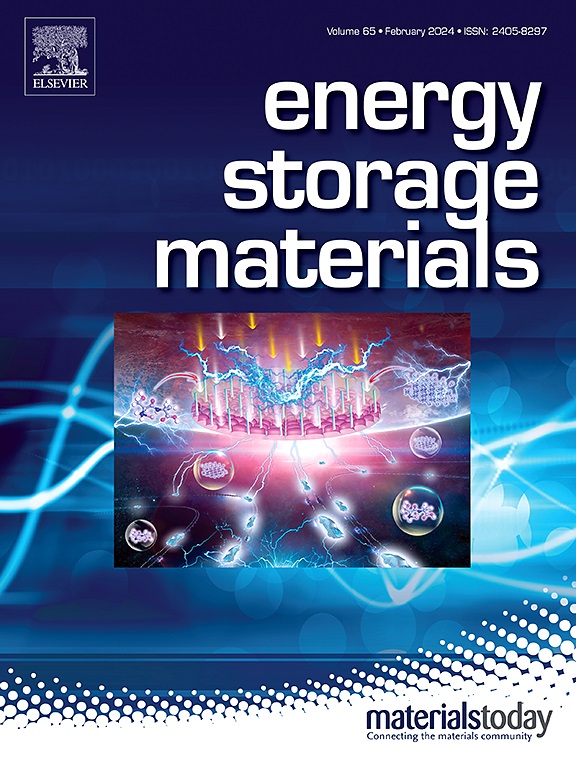Degradation Mechanisms of LiNi0.5Mn0.3Co0.2O2/graphite Battery in Real-Life Driving Scenarios
IF 18.9
1区 材料科学
Q1 CHEMISTRY, PHYSICAL
引用次数: 0
Abstract
Understanding the aging mechanisms of lithium-ion batteries (LIBs) in real-life driving scenarios is the key to advancing battery design and management for electric vehicles. This work studies in detail the aging modes of commercial LIBs under real-life driving scenarios with a standardized World Harmonized Light Vehicle Test Cycle (WLTC) discharging procedure. Combined results from electrochemical analyses, post-mortem, and operando characterization show that a large depth of DOD (100%) leads to significant structural changes, especially Ni-O bond length and coordination number, of NMC532 cathode materials and hence rapid degradation related to active material loss, while a low DOD level (45%) results in intensified interfacial degradation, both leading to a limited battery cycle life (<900 and <1600 equivalent full cycles (EFCs), respectively, under 45% and 100% DoDs). In contrast, a medium DOD (75%) results in balanced electrode and interface degradations and significantly enhanced cycling stability (>2200 EFCs under 75% DoDs). Besides, we also emphasized that in real-life driving, the loss of active materials primarily originates from the cathode. These findings reveal that balancing the electrode and interfacial degradations are crucial for extending battery lifetime in practical applications. This work provides mechanistic insights into the degradation of LIBs under real-life operating conditions, guiding the rational design and optimization of cycling protocols in battery management systems (BMSs) for advanced battery development.LiNi0.5Mn0.3Co0.2O2/石墨电池在实际驾驶场景下的降解机理
了解锂离子电池(LIBs)在实际驾驶场景中的老化机制是推进电动汽车电池设计和管理的关键。本文采用标准化的世界统一轻型车辆测试周期(WLTC)放电程序,详细研究了商用lib在实际驾驶场景下的老化模式。电化学分析、后期分析和operando表征的综合结果表明,大的DOD深度(100%)会导致NMC532正极材料的显著结构变化,尤其是Ni-O键长度和配位数,从而导致与活性物质损失相关的快速降解,而低的DOD水平(45%)会导致界面降解加剧,两者都会导致电池循环寿命有限(分别为<;900和<;1600等效全循环(EFCs))。低于45%和100%的DoDs)。相比之下,中等DOD(75%)会导致平衡电极和界面退化,并显着增强循环稳定性(75% DOD下>;2200 EFCs)。此外,我们还强调,在实际驾驶中,活性物质的损失主要来源于阴极。这些发现表明,在实际应用中,平衡电极和界面的退化对于延长电池寿命至关重要。这项工作为实际操作条件下锂电池的降解提供了机制见解,指导电池管理系统(bms)中循环协议的合理设计和优化,以促进先进电池的开发。
本文章由计算机程序翻译,如有差异,请以英文原文为准。
求助全文
约1分钟内获得全文
求助全文
来源期刊

Energy Storage Materials
Materials Science-General Materials Science
CiteScore
33.00
自引率
5.90%
发文量
652
审稿时长
27 days
期刊介绍:
Energy Storage Materials is a global interdisciplinary journal dedicated to sharing scientific and technological advancements in materials and devices for advanced energy storage and related energy conversion, such as in metal-O2 batteries. The journal features comprehensive research articles, including full papers and short communications, as well as authoritative feature articles and reviews by leading experts in the field.
Energy Storage Materials covers a wide range of topics, including the synthesis, fabrication, structure, properties, performance, and technological applications of energy storage materials. Additionally, the journal explores strategies, policies, and developments in the field of energy storage materials and devices for sustainable energy.
Published papers are selected based on their scientific and technological significance, their ability to provide valuable new knowledge, and their relevance to the international research community.
 求助内容:
求助内容: 应助结果提醒方式:
应助结果提醒方式:


